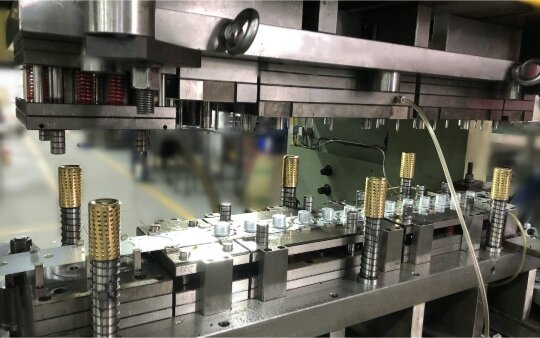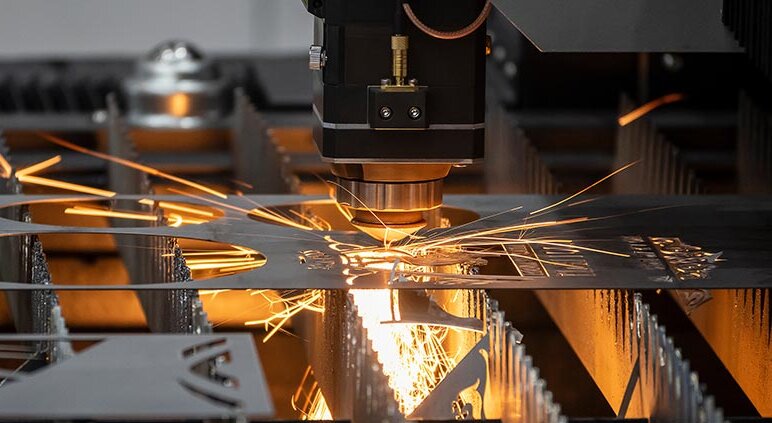Why Hardware Integration Matters From Day One?
Hardware is often a small detail in a sheet metal assembly, yet it influences almost everything: mechanical strength, assembly speed, long-term durability, field service, and even compliance with certifications.
Sheet metal is thin. It cannot hold threads reliably. That’s why مهمات الربط like self-clinching nuts, studs, standoffs, and rivet nuts become “structural extensions” of the material. When these parts are selected early, the project moves smoothly. When they are considered late, problems pile up—often in costly ways.
Common consequences of late or poor hardware planning include:
- Holes that don’t match hardware tolerance → installation failure
- Hardware rotating or popping out during assembly → line stoppage
- Bends deforming the hole → hardware cannot be inserted
- Wrong material pairing → galvanic corrosion within months
- Hardware blocking brake tooling → bending sequence must be changed
- Surface finishing issues → flakes, burns, or failed cosmetic checks
- Unexpected handwork → higher cost, longer lead time
- Rejected parts during torque or pull-out tests
Hardware is not just a “finishing step.” It is a core element of sheet metal design. Thinking about it early helps every project run with fewer risks.

Choosing the Right Hardware Type
Sheet metal hardware comes in many forms. Each type has different rules for installation, spacing, strength, and material compatibility.
Self-Clinching Nuts and Studs
These are widely used because they provide strong threads in thin gauges. However, they only work well when:
- The sheet metal is softer than the hardware
- The hole is within tight tolerance
- There’s enough space around the hole for metal flow
If these conditions are not met, the stud or nut may not clinch properly and can loosen over time.
Standoffs and Pins
Helpful in creating spacing or grounding points. Taller standoffs require more surrounding material to avoid distortion during installation.
Rivet Nuts
A good choice when the sheet is too hard or too thin for clinching. They install from one side, making them ideal for tubes or enclosed spaces. But they require consistent hole sizes; even a small over-tolerance can cause spin-out.
Welded Hardware
Best for high-load situations, but introduces heat. Thin sheet metal may warp, creating issues in later assembly steps. لحام also affects the surface appearance, which is essential for visible panels.
Removable vs. Permanent Hardware
For products requiring frequent maintenance, such as electrical enclosures, removable hardware is often the better option. For permanent structural connections, clinched or welded hardware usually performs better.
Material Compatibility and Hardness Matching
Hardware must be more complex than the sheet metal to allow proper displacement during installation. When the sheet is more rigid, the metal cannot flow, and the hardware will not seat correctly.
Examples of common mismatches:
- Stainless sheet with aluminum hardware → installation failure
- Hard cold-rolled steel with mild steel hardware → insufficient locking
- Aluminum housings with plain steel fasteners → galvanic corrosion
Galvanic corrosion is particularly problematic in outdoor or humid environments. Designers should pair materials carefully or choose coatings that isolate dissimilar metals.
Real-world impact: A telecom enclosure installed near the coast failed after six months because carbon-steel hardware reacted with anodized aluminum, causing the studs to loosen.
| Sheet Metal Material | Recommended Hardware Material | Not Recommended Pairing | Reason / Notes |
|---|---|---|---|
| Aluminum (Anodized or Raw) | Stainless Steel (304/316), Hard-Anodized Aluminum | Plain Carbon Steel | High galvanic corrosion risk, especially in humid areas. |
| الألومنيوم | Zinc-Plated Steel | Copper or Brass | Copper causes rapid corrosion when touching aluminum. |
| Stainless Steel (304/316) | Hardened Stainless Steel, Zinc-Plated Steel | Soft Aluminum Hardware | Aluminum hardware is too soft; it deforms during installation. |
| الصلب المدرفل على البارد (CRS) | Zinc-Plated Steel, Stainless Steel (indoor use) | Raw Copper or Brass | Corrosion risk when moisture is present. |
| الصلب المجلفن | Zinc-Plated Steel, Stainless with Insulation | Stainless Without Isolation | Surface corrosion may occur at contact points. |
| Copper or Brass | Stainless Steel, Nickel-Plated Steel | الألومنيوم | Copper reacts strongly with aluminum and causes corrosion. |
| التيتانيوم | Titanium Hardware, Stainless Steel | Carbon Steel, Copper or Brass | Hardness mismatch and risk of galling or contamination. |
Hole Sizes, Distances, and Bend Interaction
Small layout decisions can shape the success of hardware installation. Proper spacing and precise tolerances prevent deformation and reduce rework.
حجم الفتحة
Hardware installation tools require precise hole sizes—typically within ±0.1 mm. Too small, and the sheet cracks. Too large, and the hardware spins.
Edge Distances
If hardware is too close to an edge, the sheet may distort or bulge during installation. This weakens pull-out and torque resistance.
Bend Distances
Holes near bend lines often become oval after forming. Once distorted, hardware can no longer sit properly in place.
Interference With Other Components
Hardware height, footprint, and شفة positions must be checked in 3D to avoid collisions with:
- Bending tools
- Internal components
- External panels
- تصاعد بين قوسين
Real scenario: A designer placed studs near a 90° flange. After forming, the press brake tooling could not reach the bend location because the studs blocked the punch. The entire bending sequence had to be re-engineered.

Installation Methods and When to Use Them
Different installation methods create different levels of strength and stability. Choosing the correct method ensures cleaner assembly and consistent results.
حسم
Clinching presses hardware into the metal. The sheet flows into grooves on the hardware. This method is fast and strong when the material is softer than the hardware. It is not suitable for very hard or very thin sheets.
Rivet Nuts
Rivet nuts work from one side. They are great for tubes and enclosed parts. But they need a consistent installation force. If the force is uneven, the threads may tilt. Tilted threads cause cross-threading during assembly.
لحام
Welding gives high strength. It is suitable for heavy loads or vibration. But it needs control. Heat may warp thin sheets or affect coatings.
Adhesive-Bonded Hardware
Less common but useful for delicate surfaces or light-duty connections. Not suitable for high temperatures or vibrations.
When to Install?
A general rule:
- Install hardware before bends when there is no height interference.
- Install after bends when hardware blocks tooling or stands too tall.
Skipping this planning step often leads to rework or unconventional hand-bending to avoid interference, which increases cost.
Designing for Assembly Efficiency
Smart hardware placement speeds up production and lowers labor effort. Simple layout improvements make assembly smoother for operators.
Standardizing Hardware
Using a small family of hardware (for example, limiting threads to M3/M4/M5) dramatically reduces:
- Purchasing complexity
- Inventory cost
- Operator training time
- Setup changes
- Lead time variability
Standardization is one of the simplest ways to cut costs without sacrificing performance.
Assembly Access
Installers need room for tools, fingers, and fixtures. A location that “looks fine in CAD” may be impossible to reach on the line. Leaving even 3–5 mm extra clearance around the hardware area often prevents production delays.
Maintenance Considerations
If the customer needs to open or service the product repeatedly, using permanent hardware where removable hardware is required can lead to frustration and field failures.

Quality Control and Long-Term Reliability
Hardware strength depends on consistent checks during production. Testing confirms that each installed fastener performs as expected.
Pull-Out Testing
Ensures the hardware can handle expected loads. Minor deviations—such as a 0.2 mm extra hole size—can reduce pull-out strength by 20–30%.
Torque Testing
Checks rotational resistance. Rotational failures often occur after finishing processes such as painting or anodizing.
الفحص العيني
Technicians check for:
- Distorted holes
- Cracked surrounding material
- Uneven seating height
- Damage during bending
Consistency matters even more in mass production.
Common Mistakes Designers Often Make
Many recurring issues come from avoidable design decisions. Knowing these mistakes helps you build more reliable parts.
- Putting hardware on or extremely close to a bend
- Assuming any hardware works with any sheet material
- Forgetting that التشطيب (like مسحوق الطلاء) adds thickness that affects thread engagement
- Using too many hardware types
- Ignoring the assembly sequence
- Not considering operator access
- Treating hardware as “just a last step”
These mistakes typically surface during prototype reviews or, worse still, during mass production, when fixes become expensive.
Practical Real-World Examples
Practical scenarios demonstrate how hardware choices affect real-world projects. These examples illustrate the importance of effective planning and thorough review.
Scenario 1: Distorted Holes After Bending
A chassis needed M4 studs near a bend. The holes ovalized during the forming process, making installation impossible. The part required rework, and the entire bending sequence changed.
Scenario 2: Spinning Rivet Nuts
Rivet nuts installed into oversize holes spun during torque testing. Production stopped until the drawings were corrected.
Scenario 3: Corrosion After Shipment
A batch of aluminum panels used uncoated steel hardware. After six months in a humid warehouse, the hardware seized and required forceful removal. The design was updated with corrosion-resistant hardware.
Scenario 4: Hardware Blocking Tooling
Tall standoffs installed before bending prevented the part from fitting into the brake. Operators had to bend by hand, which significantly slowed production.
خاتمة
High-quality sheet metal products rely on thoughtful hardware planning. Early decisions about material pairing, hardware type, hole tolerance, spacing, and assembly sequence prevent costly surprises down the line.
If you’re designing a sheet metal product and want to avoid production risks, our engineering team can help you refine the hardware selection and layout before any metal is cut.
You can get:
- A clear DFM report focused on hardware placement, spacing, and manufacturability
- Suggestions for material and coating combinations that prevent corrosion
- Hardware standardization advice to reduce long-term cost
- Fast, accurate quotations based on your drawings or CAD files
Share your design with us today, and get a practical, engineer-level review within 24 hours. Let’s build a cleaner, stronger, and more reliable product—without the production drama.
مهلا، أنا كيفن لي

على مدى السنوات العشر الماضية، كنت منغمسًا في أشكال مختلفة من تصنيع الصفائح المعدنية، وشاركت رؤى رائعة هنا من تجاربي عبر ورش العمل المتنوعة.
ابقى على تواصل

كيفن لي
لدي أكثر من عشر سنوات من الخبرة المهنية في تصنيع الصفائح المعدنية، وتخصصت في القطع بالليزر، والثني، واللحام، وتقنيات معالجة الأسطح. كمدير فني في شنغن، أنا ملتزم بحل تحديات التصنيع المعقدة ودفع الابتكار والجودة في كل مشروع.



